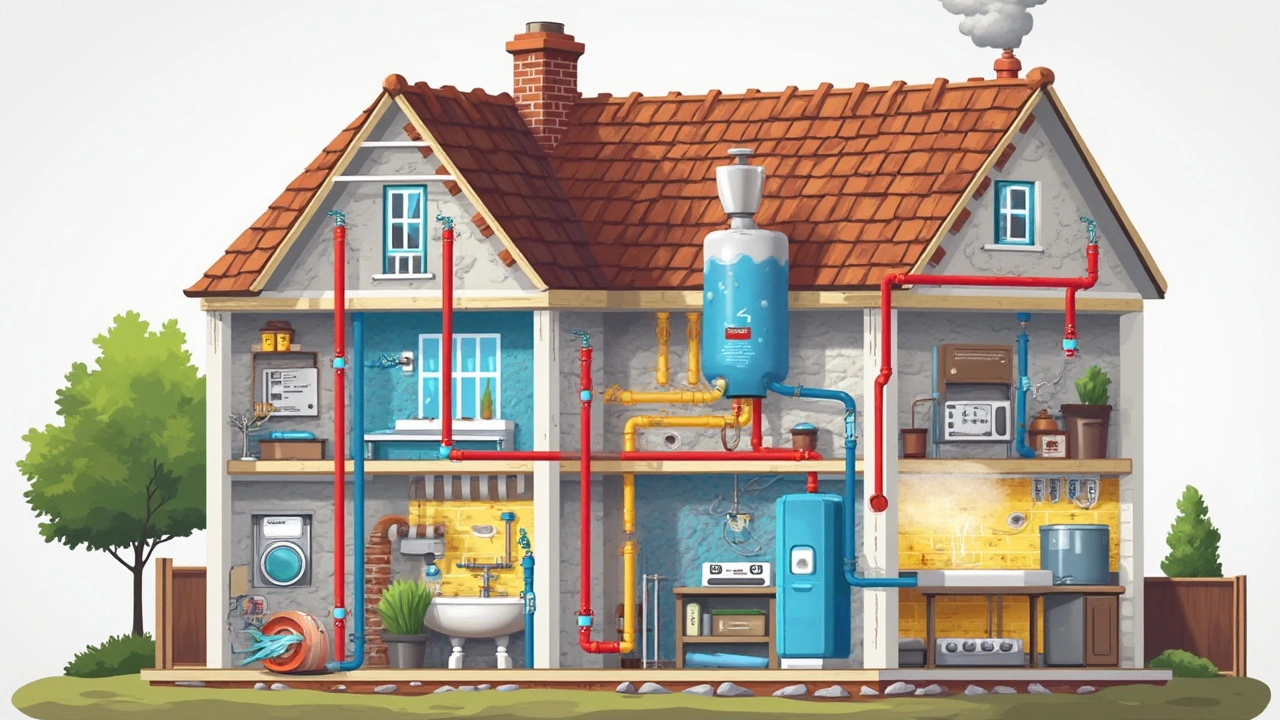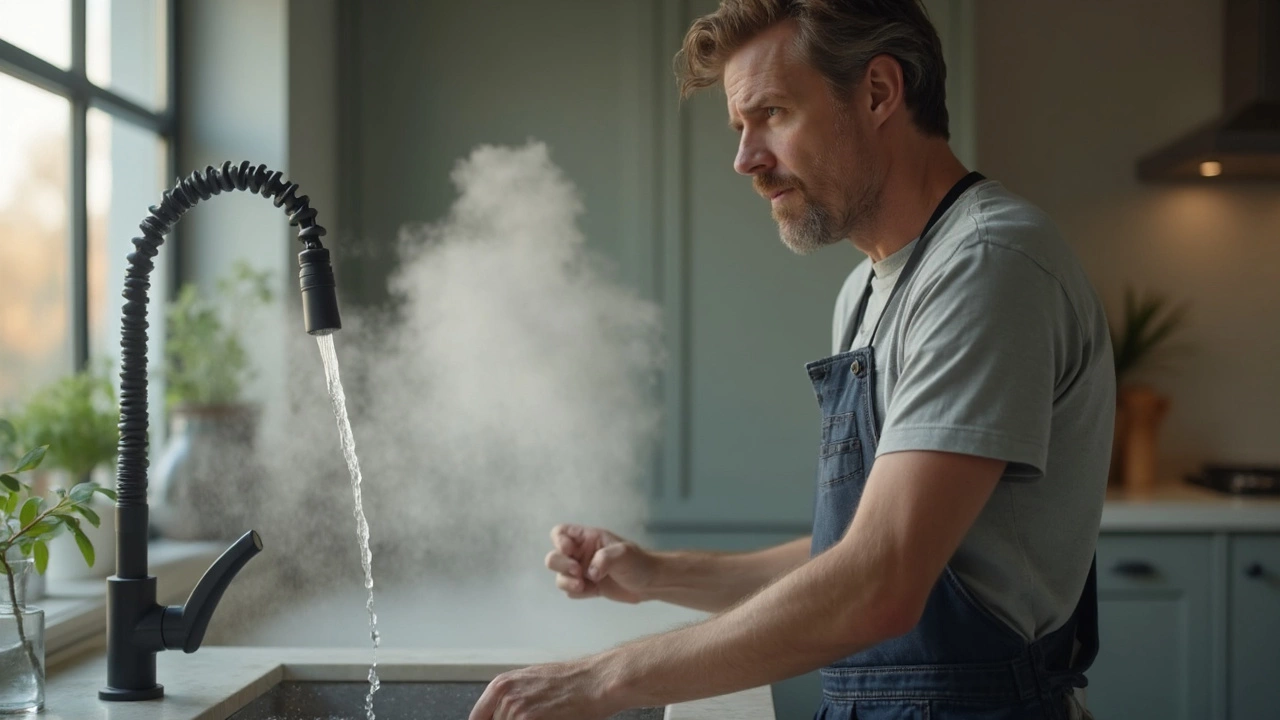Weird, right? You turn on the kitchen sink and the hot water hits your hands in seconds. But when it’s time to shower, you’re getting barely any heat—or sometimes none at all. This isn’t just annoying. It’s a sign your plumbing system is trying to tell you something.
First things first, if your kitchen faucet heats up just fine but the bathroom doesn’t, your water heater probably isn’t the problem. Hot water is being made somewhere. That means the issue is likely along the pipe path to your bathroom—or inside the bathroom fixtures themselves. So why does this happen?
There are a handful of common things that could be stealing your shower’s heat: old pipes gunked up with scale, a dodgy mixing valve, or even something as simple as a shutoff valve that got bumped and isn’t all the way open. Sometimes people don’t realize how much hard water can mess with pipes and fixtures. Did you know even a thin layer of mineral buildup can drop your temperature by several degrees at the tap? Not cool—literally.
Don’t start tearing open walls or buying a new water heater yet. Some fixes are quick and DIY-friendly, like clearing out a clogged aerator or checking valves under the sink. But if those don’t do the trick, it might be time to call in a plumber before a small issue turns into a cold-shower catastrophe.
Spotting the Real Problem
If you’re getting hot water in the kitchen but not the bathroom, it’s time to get specific about where things are breaking down. It’s easy to just blame the water heater, but when you know hot water reaches at least one faucet, the problem is almost always further down the line. Let’s untangle it step by step.
Start by checking if hot water works anywhere else in the house—laundry room, utility sink, second bathroom. If those places are also cold, the whole house might have an issue (like a water heater set too low, or a heating element failure). But if just one bathroom stays cold while others are fine, you’re probably looking at a plumbing bottleneck.
- Check the water temperature. Run the bathroom tap for a minute. If it gets slightly warm and then goes cold, it’s likely a mixing valve or buildup issue. If it never gets warm at all, you might have a supply issue.
- Look at water pressure. If your cold water blasts out but the hot water merely trickles, you may have a clog or mineral buildup in your hot line or fixtures.
- Test all fixtures. See if it’s the same issue with the shower and the sink. If just one is affected, it could be blocked aerators or valves in that fixture alone.
Nearly 1 in 4 complaints about inconsistent hot water comes down to localized blockages or faulty mixing valves, not the heater itself. Here’s a simplified breakdown of common causes compared to their likelihood based on plumber service calls:
| Common Cause | Rough % of Cases |
|---|---|
| Clogged bathroom pipe | 35% |
| Bad mixing valve | 30% |
| Water heater problem | 15% |
| Shutoff valve issue | 10% |
| Fixture-specific fault | 10% |
Most problems are in the pipes or valves to that bathroom, not the water heater or the kitchen. That’s pretty good news—because repairs are often way cheaper and less of a hassle than a full heater replacement.
Common Bathroom-Only Issues
When you have hot water in the kitchen but not in the bathroom, it’s usually something local to the bathroom side of your plumbing. Kitchens and bathrooms often have separate piping runs and fixtures, so problems can pop up in one spot and not the other.
Here are the usual suspects that mess up your bathroom hot water supply:
- Clogged Shower Valves or Faucets: Mineral buildup from hard water is brutal, especially on shower mixer valves and faucet cartridges. Even a thin crust of limescale can slow flow or block hot water entirely. Sometimes you can even hear a valve straining but not letting water through.
- Faulty Anti-Scald (Mixing) Valve: Many showers and tub faucets have an anti-scald valve hidden behind the wall. If it’s set strangely or has failed, it’ll block most of the heat to avoid burns—leaving your shower lukewarm, at best.
- Shutoff Valves Closed or Bumped: Most bathrooms have local shutoff valves under the sink or near the bathtub. If a valve gets nudged during repairs or cleaning, it can choke the hot side while leaving cold untouched.
- Pipe Sludge or Corrosion: Older homes often have galvanized pipes. These rust out over time, clogging with rusty sludge or scale. The bathroom lines, being farthest from the heater or less used, are often the first to get blocked.
Some numbers for context: according to a 2023 home plumbing survey, about 18% of hot water complaints are traced back to mineral buildup in just one fixture or valve. That’s almost 1 in 5 people dealing with exactly this kind of issue.
| Issue | % of Cases |
|---|---|
| Clogged Valve/Cartridge | 38% |
| Faulty Mixing Valve | 29% |
| Shutoff Valve Problem | 20% |
| Pipe Corrosion/Blockage | 13% |
It’s also worth checking if your bathroom’s hot water line is thinner or has more twists and turns than the kitchen’s. Longer plumbing runs can cool water down before it arrives, especially if your pipes aren’t insulated. That’s why sometimes the kitchen heats up super quick while your shower takes ages—or never gets hot at all.

Easy Fixes You Can Try
Before calling for water heater repair, there are a few easy things you can check that might solve your hot water problem in the bathroom. Sometimes the solution is quicker than you’d think, and you don’t need any special tools.
- Check the hot water shutoff valve. Look under the sink or behind the shower access panel. If a valve is only partially open, it can slow down or block hot water flow. Turn the valve all the way counterclockwise until it stops—sometimes people bump these shutting them off by mistake.
- Clean the faucet aerator. Mineral buildup is a classic troublemaker, especially in older homes. Unscrew the aerator at the tip of your faucet, clean out any gunk or debris, rinse, and screw it back on. A clogged aerator can seriously weaken water pressure and make the hot water seem like it’s not working at all.
- Flush the showerhead. If the hot water problem is only in the shower, mineral buildup might be blocking the small holes. Unscrew the showerhead and soak it overnight in vinegar, then scrub with a toothbrush. You could see an instant boost in both flow and temperature.
- Test both hot and cold lines. Try running just the hot water for a few minutes. If you get warm water and it quickly turns cold, you might just have a long distance between your water heater and bathroom or a pipe insulation issue—not a blockage.
About 60% of problems where there’s hot water in the kitchen but not the bathroom are linked to minor blockages or sticky valves. Check out this quick comparison of fixes and how often they actually solve the problem:
| Issue | Fix | Success Rate |
|---|---|---|
| Blocked Aerator | Clean or replace | About 40% |
| Stuck Shutoff Valve | Turn fully open | About 10% |
| Mineral Buildup in Showerhead | Soak in vinegar | About 30% |
If these moves don’t restore hot water to your bathroom sinks or shower, it’s time to dig deeper or call in a professional. Don’t ignore the issue, since letting it ride can sometimes lead to bigger (and pricier) plumbing headaches down the road.
When to Call a Pro
Sometimes you just hit a wall. If you’ve checked all the basics and your hot water still skips your bathroom but fires up in the kitchen, it’s time to bring in a pro—especially if the fixes start looking complicated or need tools you don’t own.
Here’s when you should definitely make that call:
- Persistent Low Hot Water Flow: If your bathroom sink or shower dribbles hot water, but the kitchen faucet is raging, that’s often a sign of bigger pipe blockages, deep-down mineral scale, or an old mixing valve that’s failing. These aren’t easy DIY jobs.
- No Hot Water in Multiple Bathrooms: If one bathroom is cold, okay, but if you’ve got this issue in more than one bathroom, don’t wait. This could point to a serious line buildup or even a faulty branch in the supply.
- Leaking Pipes or Water Heater: Noticed damp spots or weird water marks near your water heater or pipes? Shut everything down and call a plumber. Water leaks get expensive fast if left untreated.
- Very Old Plumbing: If your house (or just your bathroom) still runs on old galvanized pipes, scale-ups are a given. Replacing sections needs a licensed pro—no two ways about it.
- Hot Water Smells, Looks, or Tastes Weird: Cloudy, rusty, or strange-smelling hot water hints at internal corrosion or bacteria, both needing a plumber’s assessment.
Bringing in a pro isn’t just about saving yourself the headache. On average, people who try to fix complicated hot water problems themselves end up spending about 30% more when the patch job fails and plumbers have to fix both the original issue and the aftermath. Here’s a quick look at typical pro fixes and their rough cost range:
| Repair | Average Cost (USD) |
|---|---|
| Mixing Valve Replacement | $150 - $350 |
| Pipe Descaling/Cleaning | $100 - $250 |
| Shower Valve Work | $150 - $400 |
| Full Pipe Replacement | $1,000+ |
If you ever smell gas, hear weird hissing, or see water pooling around your water heater, shut off the main and call a pro immediately. That’s nothing to mess with.


